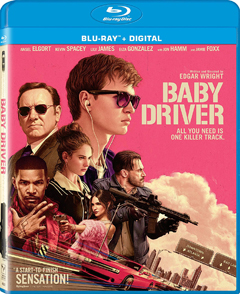At one point in “Baby Driver” — now available via Redbox and streaming — the gunshots are in perfect sync with the beats from the song in Baby’s (Ansel Elgort) earphones. It’s one example of the clever conceit behind the latest film from Edgar Wright, known for helming Simon Pegg’s funny British films like “Shaun of the Dead” and “Hot Fuzz.”
The concept is that we’ll enjoy a heist movie on a pure visceral level. Indeed, the opening chase set to “Bellbottoms” by the Jon Spencer Blues Explosion is amazing – like a car-fu answer to “John Wick’s” gun-fu.
But that momentum isn’t sustained, and the focus on car chases and music is contrasted with thin characters and a familiar plot. Baby – who listens to iPods to drown out his tinnitus — is the classic good guy in a bad situation: He tried to steal a car belonging to crime kingpin Doc (Kevin Spacey), and now he’s stuck as his getaway driver, perpetually in his debt. If not for his amazing skill, Doc probably would’ve killed him.
Spacey is slimy, something he does well, but Doc is underdeveloped and he makes a final-act turn that’s unearned. Everyone else is one note, albeit in entertaining ways since they are great actors – Jon Hamm, Eiza Gonzalez, Jamie Foxx and Jon Bernthal are among the thieves who work for Doc.
The romance between Baby and cute waitress Debora (Lily James) is old fashioned, but it works on that level. They meet, they dig each other, and they’re gonna flee their crappy lives and drive cross country like they’re in a Bruce Springsteen song (the Boss does not get needle-dropped in the film, though).
A lot of the music is the same as what I have on a “Beverly Hills, 90210: Songs from the Peach Pit” CD — the jukebox era – although Queen’s “Brighton Rock” is Baby’s favored getaway tune.
Unlike most films, where the music is added in post-production, Wright shot the action scenes like music videos where the tunes line up with the action. It’s diegetic to Baby but non-diegetic to the other characters, and the idea is that this will bring us into Baby’s head so we’re seeing everything from his point of view.
“Baby Driver” doesn’t totally achieve that. I think it’s because, if this were real, characters who can’t hear the music wouldn’t sync their gun blasts to the beat. Also, Baby uses music as an escape – and since he always plays music, it’s a perpetual escape. We can’t get too close to him or anyone else. The result is often highly entertaining, but it doesn’t leave a lasting impression.

